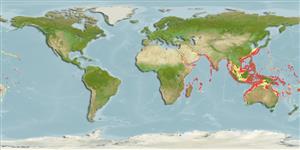>
Eupercaria/misc (Various families in series Eupercaria) >
Lutjanidae (Snappers) > Etelinae
Etymology: Pristipomoides: Greek, pristis = saw + Greek, poma, -atos = cover, operculum + Greek, oides = similar to (Ref. 45335).
More on author: Day.
Environment: milieu / climate zone / depth range / distribution range
ນິເວດວິທະຍາ
ສັດທະເລ ອາໄສຢູ່ໃກ້ໜ້າດິນໃຕ້ພື້ນທ້ອງນ້ຳ; ລະດັບຄວາມເລິກ 40 - 350 m (Ref. 9821), usually 125 - 275 m (Ref. 82366). Tropical; 32°N - 36°S, 33°E - 157°W
Indo-Pacific: East Africa and Red Sea to Samoa, and southern Japan southward to Australia.
Length at first maturity / ຂະໜາດ / ນ້ຳໜັກ / Age
Maturity: Lm 41.7, range 35 - 50 cm
Max length : 90.0 cm TL ຕົວຜູ້/ບໍ່ມີເພດ; (Ref. 5484); common length : 70.0 cm TL ຕົວຜູ້/ບໍ່ມີເພດ; (Ref. 5450); ອາຍຸສູງສຸດທີ່ເຄຍລາຍງານມາ: 30 ປີ (Ref. 46116)
ຄີ (ໜາມ)ແຂງຢູ່ຫຼັງປາ (ທັງໝົດ): 10; ຄີຫຼັງຂອງປາ (ຄີອ່ອນ) (ທັງໝົດ): 11; ຄີ(ໜາມ) ແຂງຢູ່ຄີກົ້ນປາ
ກຸ່ມປາກະດູກແຂງ
ຄວາມຖີ່ຂອງກຸ່ມຖ່າຍທອດພັນ
ປາທີ່ມີການເຄື່ອນຍ້າຍຈາກທະເລໄປຫານ້ຳຈືດ ແລະນ້ຳຈືດຫາທະເລ
ປາທີ່ມີການເຄື່ອນຍ້າຍຈາກທະເລແລະໄປໄຂ່ຢູ່ນ້ຳຈືດ
ຄີກົ້ນຂອງປາ
ສັດທີ່ມີກະດູກສັນຫັຼງ
ການຖ່າຍທອດທາງກຳມະພັນຈາກພໍ່ແມ່ຫາລູກ 3; ຄີກົ້ນຂອງປາ: 8. Interorbital space flat. Lower jaw slightly protruding. Bases of dorsal and anal fin without scales, their last soft rays extended into shorts filaments. Pectoral fins long, reaching level of anus. Scale rows on back parallel to lateral line. Side of snout and cheek with 2 golden stripes bordered with blue. Top of head with a series of chevron-shaped yellow bands.
Gold band snappers are deepwater fish inhabiting tropical and sub-tropical waters. They are schooling fish and live in areas of hard, rocky and uneven sea floor and steep off islands (Ref. 27354). They feed on fishes, shrimps, crabs, lobsters, stomatopods, squids, gastropods and urochordates. Marketed fresh. An excellent food fish. Maximum depth from Ref. 082366.
Studies in the South China Sea (Ref. 28116) and Hawaii (Ref. 28117) suggest that this species is a serial spawner (Ref. 28115). Similar studies in Australia suggest that this species is a multiple spawner, perhaps a serial spawner (Ref. 6390).
Allen, G.R., 1985. FAO Species Catalogue. Vol. 6. Snappers of the world. An annotated and illustrated catalogue of lutjanid species known to date. FAO Fish. Synop. 125(6):208 p. Rome: FAO. (Ref. 55)
IUCN Red List Status (Ref. 130435)
Threat to humans
Harmless
Human uses
ການປະມົງ: ເປັນສີນຄ້າ
ຂໍ້ມູນຕື່ມອີກ
ເອກະສານອ້າງອີງການລ້ຽງສັດນ້ຳຂໍ້ມູນການລ້ຽງສັດນ້ຳສາຍພັນກຳມະພັນElectrophoresesການຖ່າຍທອດທາງກຳມະພັນຈາກພໍ່ແມ່ຫາລູກພະຍາດການປຸງແຕ່ງNutrientsMass conversion
ຜູ້ຮ່ວມມືຮູບStamps, Coins Misc.ສຽງຫອຍມີພິດຊະນິດນຶ່ງທີ່ອາໄສໃນທະເລຄວາມໄວປະເພດການລອຍເນື້ອທີ່ເຫືອກOtolithsສະໝອງວິໄສທັດ
ເຄື່ອງມື
Special reports
Download XML
ແຫຼ່ງອີນເຕີເນັດ
Estimates based on models
Preferred temperature (Ref.
123201): 12.3 - 23, mean 17 °C (based on 372 cells).
Phylogenetic diversity index (Ref.
82804): PD
50 = 0.5005 [Uniqueness, from 0.5 = low to 2.0 = high].
Bayesian length-weight: a=0.01660 (0.01006 - 0.02739), b=2.95 (2.82 - 3.08), in cm total length, based on LWR estimates for this species & Genus-body shape (Ref.
93245).
ຊັ້ນເຂດຮ້ອນ (Ref.
69278): 3.8 ±0.58 se; based on food items.
ຄວາມຢືດຢຸ່ນ (Ref.
120179): ຂະໜາດກາງ, ປະຊາກອນຕຳ່ສຸດທີ່ໃຊ້ເວລາສອງເທົ່າ 1.4 - 4.4 ປີ (K=0.22-0.28; tmax=14; Fec=296,000).
Prior r = 0.67, 95% CL = 0.44 - 1.01, Based on 1 stock assessment.
Fishing Vulnerability (Ref.
59153): Moderate vulnerability (43 of 100).
Climate Vulnerability (Ref.
125649): High to very high vulnerability (75 of 100).
Nutrients (Ref.
124155): Calcium = 71.6 [28.0, 146.4] mg/100g; Iron = 0.886 [0.467, 1.509] mg/100g; Protein = 18.3 [16.5, 19.9] %; Omega3 = 0.247 [0.147, 0.429] g/100g; Selenium = 90.7 [50.6, 173.7] μg/100g; VitaminA = 14.3 [4.8, 44.4] μg/100g; Zinc = 0.823 [0.551, 1.196] mg/100g (wet weight);
